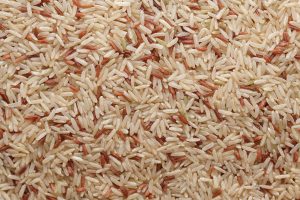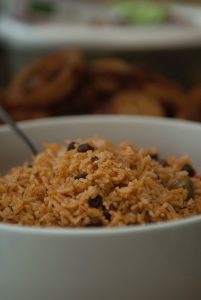
With more and more people becoming aware of the importance of eating healthy, brown rice is becoming an increasingly popular food choice. Brown rice is a whole grain that is full of vitamins, minerals, fiber, and other beneficial nutrients. It also has a mild, nutty flavor that makes it a great base for stir-fries, rice bowls, and more.
Nutritional Benefits of Brown Rice
One of the biggest nutritional benefits of brown rice is that it is a good source of fiber. Fiber is important for maintaining a healthy digestive system, and brown rice is one of the best sources of dietary fiber. It is estimated that one cup of cooked brown rice contains about 3.5 grams of fiber. This is about 14% of the recommended daily allowance (RDA) for fiber. Eating foods that are high in fiber can help to reduce cholesterol levels and keep your digestive system functioning properly.
Brown rice is also a good source of vitamins and minerals. It is a good source of B vitamins such as thiamin, niacin, and folate. These vitamins are important for energy production and maintaining healthy cells. Additionally, brown rice is a good source of minerals such as magnesium, phosphorus, and manganese. These minerals are important for bone health and metabolism.
Brown rice is also a good source of complex carbohydrates. Complex carbohydrates provide a slow and steady release of energy, which can help to keep you feeling full for longer and provide sustained energy throughout the day. This can be beneficial for people who are looking to maintain a healthy weight or who are trying to lose weight.
Brown rice is also high in antioxidants. Antioxidants are substances that can help to protect your body from the damaging effects of free radicals. They can also help to reduce inflammation and protect cells from damage. Eating foods that are high in antioxidants can help to protect your body from disease and promote overall health.
Brown rice is low in calories. One cup of cooked brown rice contains only about 215 calories, which is much lower than other grains. This makes it a great option for people who are looking to lose weight or maintain a healthy weight.
History of Brown Rice
The earliest known evidence of brown rice consumption dates back to around 5,000 BC, where it was grown in the region of present-day China. It was a staple food of the Chinese diet and was used to make porridge and gruel. Brown rice was also a popular food in ancient India, where it was used in simple dishes such as boiled rice and vegetable mixtures. The ancient Greeks and Romans also enjoyed brown rice, and it was a popular food in ancient Egypt, as well as in other parts of Africa.
In the Middle Ages, brown rice was a popular food throughout Europe. It was often eaten with other grains, such as wheat and barley, or mixed with other ingredients to make dishes such as pottage, which was a thick, soupy stew. Brown rice was also used to make the staple food of the medieval diet, a dish known as frumenty.
In the 1600s, brown rice was introduced to the Americas by Spanish and Portuguese explorers. They brought the grain with them and began to cultivate it in the New World. The rice quickly spread throughout the continent and was a popular food in the South and Southwest, as well as in parts of the Caribbean.
In the 1700s, brown rice began to gain more popularity in Europe and North America, where it was used to make dishes such as risotto and pilaf. In the 1800s, the industrial revolution saw a boom in the production of brown rice, as well as other grains. This made it more widely available, and it soon became a popular food in many parts of the world.
Today, brown rice continues to be a popular food in many countries around the world, from the UK and US to countries in Asia and Africa. It is still a staple food of many diets and is used to make dishes such as risotto, pilaf, and sushi. Brown rice is also used in a variety of recipes, from soups and salads to curries and stir-fries.
Cooking with Brown Rice
Cooking with brown rice is becoming increasingly popular as people become more health conscious.

Brown rice is a whole grain, so it contains all three parts of the grain – the bran, germ and endosperm. This means that it has more fiber and more vitamins and minerals than white rice, which has been milled and had the bran and germ removed. Brown rice is also a good source of magnesium, which helps keep your blood pressure and cholesterol levels in check, and it is high in antioxidants, which can help protect against cancer.
The first step in cooking with brown rice is to rinse it. Like any whole grain, brown rice can contain dirt and debris, so it should be rinsed before cooking to remove any impurities. Once rinsed, you should combine the rice and water in a pot, as you would with white rice, and bring to a boil. The cooking time may be slightly longer than with white rice, but the results are worth it.
Once the rice is cooked, it can be used in a variety of dishes, including soups, salads, and casseroles. It can also make a great side dish for your favorite proteins. For a simple yet flavorful side dish, try cooking the brown rice with some garlic, onion, and herbs.
When cooking with brown rice, it is important to remember that it can go rancid easily if not stored properly. Store it in an airtight container in a cool, dry place and it should last for a few months. If you don’t plan on using it within a few months, you can also store it in the freezer for up to a year.
Brown rice is a great addition to any meal, and the possibilities are endless. From salads to main dishes, there are many delicious and nutritious recipes that can be made with brown rice. Taking the time to learn how to properly cook and store it will help ensure that you get the most out of your brown rice. So, don’t be afraid to cook with brown rice – it’s definitely worth it.
Clinical Trials on Brown Rice
The clinical trials on brown rice have been conducted in both animals and humans in order to determine the safety and efficacy of brown rice as a food. Several controlled studies have been conducted that have looked at the effects of brown rice on blood sugar levels, cholesterol, and other biomarkers. These studies have found that brown rice can help to reduce the risk of type 2 diabetes, lower cholesterol and reduce blood pressure.
In a randomized, controlled trial conducted by the University of Tokyo, researchers tested the effects of brown rice on metabolic syndrome in humans. The study included 32 participants and lasted for 12 weeks. The participants were split into two groups with one group consuming white rice and the other consuming brown rice. The results of the study showed that the brown rice group had significantly lower levels of body fat percentage and waist circumference compared to the white rice group. In addition, the brown rice group had significantly higher levels of HDL cholesterol and significantly lower levels of LDL cholesterol and triglycerides.
In a study conducted by the Harvard Medical School, the researchers tested the effects of brown rice on blood sugar control in type 2 diabetes. The study included 124 participants and lasted for 16 weeks. The participants were split into three groups, with one group consuming white rice, one group consuming brown rice, and one group consuming a combination of white and brown rice. The results of the study showed that the group that consumed brown rice had significantly lower levels of fasting glucose, glycosylated hemoglobin, and systolic and diastolic blood pressure compared to the other groups.
In a study conducted by the Stanford University School of Medicine, researchers tested the effects of brown rice on weight loss in obese individuals. The study included 55 participants and lasted for 24 weeks. The participants were split into two groups, with one group consuming white rice and the other consuming brown rice. The results of the study showed that the group that consumed brown rice had significantly lower body weight, body fat percentage, waist circumference, and BMI compared to the other group.